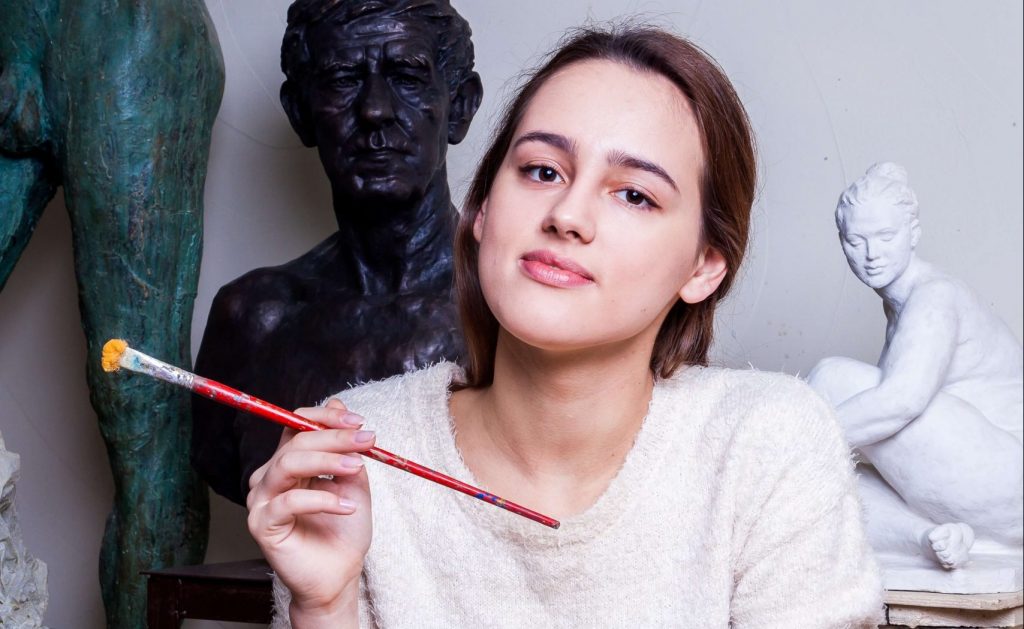Student-centric advice and objective recommendations
Higher education has never been more confusing or expensive. Our goal is to help you navigate the very big decisions related to higher ed with objective information and expert advice. Each piece of content on the site is original, based on extensive research, and reviewed by multiple editors, including a subject matter expert. This ensures that all of our content is up-to-date, useful, accurate, and thorough.
Our reviews and recommendations are based on extensive research, testing, and feedback. We may receive commission from links on our website, but that doesn’t affect our editors’ opinions. Our marketing partners don’t review, approve or endorse our editorial content. It’s accurate to the best of our knowledge when posted. You can find a complete list of our partners here.
Art Major Overview
 By
Zach Skillings
By
Zach Skillings 
Zach Skillings is the Scholarships360 Newsletter Editor. He specializes in college admissions and strives to answer important questions about higher education. When he’s not contributing to Scholarships360, Zach writes about travel, music, film, and culture. His work has been published in Our State Magazine, Ladygunn Magazine, The Nocturnal Times, and The Lexington Dispatch. Zach graduated from Elon University with a degree in Cinema and Television Arts.
Full BioLearn about our editorial policies

Maria Geiger is Director of Content at Scholarships360. She is a former online educational technology instructor and adjunct writing instructor. In addition to education reform, Maria’s interests include viewpoint diversity, blended/flipped learning, digital communication, and integrating media/web tools into the curriculum to better facilitate student engagement. Maria earned both a B.A. and an M.A. in English Literature from Monmouth University, an M. Ed. in Education from Monmouth University, and a Virtual Online Teaching Certificate (VOLT) from the University of Pennsylvania.
Full BioLearn about our editorial policies

Whether through the stroke of a paint brush or the strum of a guitar, artists have the incredible power to inspire. As Robin Williams’ character declared in Dead Poets Society, “Medicine, law, business, engineering – these are noble pursuits and necessary to sustain life. But poetry, beauty, romance, love – these are what we stay alive for.” And if you ask us, the list of things that make life worth living isn’t complete without art. Becoming an artist takes talent, but it also requires education and training. If you have dreams of turning your artistic passions into a career, you should consider declaring an art major.
Related: Top art scholarships
What is an art major?
If you’re pursuing an education within the wide world of art, there are several routes you can take. From painting and photography to graphic design and live performance, there’s many disciplines that fall under the general umbrella of art. Although there’s a multitude of specializations, degrees in this realm are usually categorized as either fine arts or media arts:
Fine arts
These are the artistic fields that usually come to mind when thinking about “traditional art”. Students majoring in fine arts typically study disciplines such as painting, drawing, sculpting, pottery, theatre, music, and dance. Some schools may take an interdisciplinary approach to the major, offering students the chance to dabble in various art forms throughout their studies. Other schools may offer specialized programs that allow students to hone a specific craft such as music, painting, or theatre. Fine arts programs may also incorporate art history courses into their curriculum.
Media arts
This discipline lies at the crossroads of art, technology, and business. Media arts students take a more career-oriented approach to their education, studying practical fields such as graphic design, video production, interior design, photography, and animation. This discipline is ideal for students who have an artistic spirit and a business-oriented mindset. They study how design and color can be used to express ideas through a variety of formats. Like the fine arts, schools offer both general media arts programs and specialized majors that focus on specific concentrations.
Also see: Top college majors for the future
Coursework to expect
Whatever discipline you choose as an art student, you can expect a healthy mix of hands-on learning and classroom study. For instance, film students learn how to use video, audio, and lighting equipment while also studying the history and theory of cinema. Similarly, painters study both the technical and theoretical aspects of their craft. Along with their art classes, students in this field are also required to complete general education courses. These may include English, humanities, math, and science classes.
Here are some potential courses you may encounter as an art major:
- Fundamentals of Design
- Three-Dimensional Design
- Art History
- Ceramics
- Painting
- Photography
- Film and Television Production
- Contemporary Issues in Art
- Advanced Color and Space
- Professional Practices in Art
Also see: How to pick a major
Opportunities after graduation
There’s no denying that art isn’t the most career-oriented major. But that doesn’t mean it’s impossible to achieve a stable and rewarding career as an artist. If you’re having a tough time conceptualizing a career as a “professional artist”, remember that not all artistic jobs involve a brush and easel. As we’ve discussed, artists come in all forms and flavors. Some are film directors, others are musicians, but all have the ability to positively impact others through their work. In the next section, we’ll cover a few practical art-related professions that are entirely achievable through higher education.
Jobs you can get with an art degree
Just because you major in art doesn’t mean you have to live out the starving artist stereotype. There’s several professions you can pursue with an art degree, and we’ve highlighted a few of them below. We’ve also included median annual salaries according to the 2022 U.S. Bureau of Labor Statistics.
1. Graphic designer
Graphic designers communicate ideas and information by using a combination of text and images. They commonly design layouts for web pages, advertisements, brochures, and magazines. Their work is done through digital illustration and photo editing software.
2022 Median Pay: $57,990 per year
Projected Growth (2022-2032): 3% (As fast as average)
Source: U.S. Bureau of Labor Statistics
Also see: Top graphic design scholarships
2. Museum curator
Museum curators oversee collections of artwork and historical items. Job responsibilities include preserving and maintaining collections, setting up exhibits, and providing educational services to the public. They’re employed by museums, historical sites, government institutions, and colleges and universities.
2022 Median Pay: $53,420 per year
Projected Growth (2022-2032): 10% (Much faster than average)
Source: U.S. Bureau of Labor Statistics
3. Art director
Art directors oversee the visual style of projects within various forms of media such as movies, TV shows, magazines, websites, and newspapers. They determine how concepts and themes should be represented visually, then communicate their vision to staff members who then bring it to life. They typically manage graphic designers, photographers, and set designers.
2022 Median Pay: $105,180 per year
Projected Growth (2022-2032): 6% (Faster than average)
Source: U.S. Bureau of Labor Statistics
Also see: Top 10 summer art programs for high school students
4. Photographer
Photographers specialize in composing images, which makes this profession a natural career choice for art majors. These professionals are experts in digital photography, lighting, and editing software. Many photographers are freelancers, while others are employed by news publications, sports teams, and colleges and universities.
2022 Median Pay: $40,170 per year
Projected Growth (2022-2032): 4% (As fast as average)
Source: U.S. Bureau of Labor Statistics
5. Interior designer
This line of work involves designing indoor spaces to make them both functional and aesthetically pleasing. They have a great eye for design and know how to make colors, lighting, and materials work in conjunction. Interior designers are commonly self-employed, but they may also work for design service companies, architectural firms, and furniture stores.
2022 Median Pay: $61,590 per year
Projected Growth (2022-2032): 4% (As fast as average)
Source: U.S. Bureau of Labor Statistics
6. Craft and fine artists
These are the folks who fit squarely within the definition of “professional artist”. Craft artists create and sell original works of art such as pottery, glassware, paintings, textiles, sculptures, and more. This is one of the more difficult professions to break into, but certainly worthwhile if you can make it work. The majority of craft artists are self-employed.
2022 Median Pay: $53,140 per year
Projected Growth (2022-2032): 4% (As fast as average)
Source: U.S. Bureau of Labor Statistics
Related: Should I switch majors? How to decide
Advanced degrees you can pursue
Many students use their bachelor’s degree in art as a stepping stone towards a master’s degree. A popular option is to continue down the artistic path and pursue a Master of Fine Arts (MFA). Students seeking an MFA typically specialize in a specific field such as photography, film production, graphic design, painting, music, or theatre. Graduate programs like this can help students refine their craft and realize their careers as artists. A master’s degree also opens up the door to teaching art at the college/university level.
Another option is to pursue a graduate program that blends art and business. Below are a few master’s programs that can help take your career to the next level:
- Art Administration
- Art Therapy
- Animation and Design
- Film Studies
How do I know if this major is right for me?
If you’re considering a major in art, ask yourself the following questions:
- Is creating and designing an integral part of your life?
- Do you have an eye for colors, patterns, and design?
- Are you passionate about movies, music, animation, painting, or dance?
- Will a degree in art help you achieve your career goals?
If you answered yes to most of these questions, then an art major could be right for you!
Also see: Top majors and careers for introverts




 SAT" printed on his pencil">
SAT" printed on his pencil">
